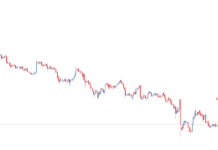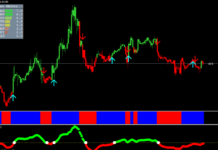Currency Slope Strength is an advanced Forex tool that measures currency power. It helps a trader determine the direction of a trend and entry points.
To determine how strong the currency is, Currency Slope Strength looks at the angle of slope of the TMA (Triangular Moving Average) lines. Instead of using the averaged TMA values, Currency Slope Strength transforms them by using its algorithm. This is how it avoids lagging which is characteristic for the TMA.

If the indicator reverses and starts moving back to zero, this means that the price momentum has slowed down. If the slope angle is positive and increasing, the currency price is growing faster. As already mentioned, Currency Slope Strength is more sensitive to price changes than TMA.
The indicator compares the strength of each currency to all other currencies. For example, you’re comparing AUD with USD, EUR, GBP, JPY, CHF, and NZD. If you remove the pairs with AUD from the list, you’ll get a different currency power chart. To measure the strength of the British pound, the indicator adds up the slope angles for all currency pairs with GBP: GBPAUD, GBPCAD, GBPCHF, GBPJPY, GBPUSD, GBPNZD, and EURGBP. The sum is then divided by the number of pairs. As a result, we get the average value of GBP strength.
The biggest advantage of the CSS indicator is that it’s easy-to-use and generates straightforward signals. A dramatic deviation from the zero line means that one currency has a solid advantage over the other. The indicator crossing the zero line means that a trend is changing its direction.
Currency Slope Indicator signals
Lines cross
- If the two lines cross, a trend is changing its direction. In this case, the indicator will notify a trader by displaying a vertical line opposite the currency values.
- If both lines are moving outside the channel, one currency starts to slow down and the other starts to speed up. This signal indicates the emergence of a strong trend, and therefore a good entry opportunity.
- Another scenario is when the lines cross near the zero line and inside the channel. Since neither currency is trending, you shouldn’t count on big profits. This signal may precede the emergence of a strong uptrend or downtrend. The best thing you can do is to wait until the situation clears up.
- One line moves inside the channel, while the other one leaves the channel. This signal says a new trend is emerging.
- One line breaks the upper boundary of the channel, while the other one breaks the opposite boundary. Usually, this signal indicates the emergence of a continuous trend. Note that the lines don’t always cross the boundaries at the same time. The crossings may be days or even weeks apart. Anyway, it’s a lucrative entry opportunity.
Lines move parallel to each other
- The two lines are moving sideways, i.e. parallel to each other. It doesn’t matter in which direction the lines are moving, up or down. The stronger currency is the one moving higher relative to the zero line.
Lines cross the channel boundaries
- Crossing of the +20/-20 levels is one of the major signals generated by the indicator. When it happens, you’ll see a green/red dot in the chart.
If used wisely, the Currency Slope Strength indicator has enough advantages to be your primary trading tool. It allows us to assess the potential of currencies in a pair at an early stage of trend formation.






Merci